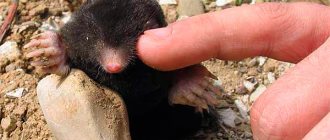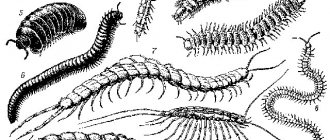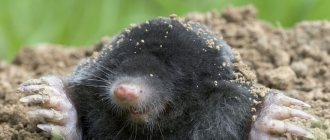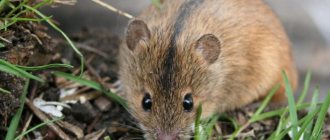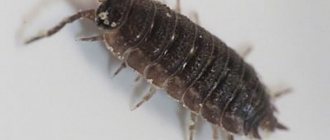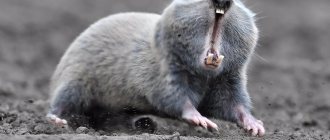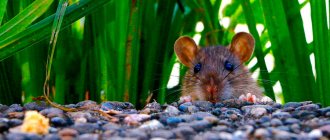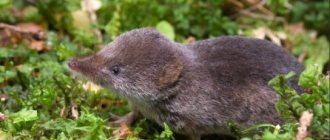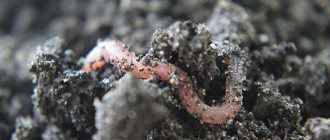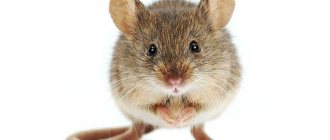A mole is an insectivorous mammal that spends almost its entire life underground. These little animals are silent and invisible, but at the same time they live almost everywhere. People often don't notice unusual animals because they rarely come to the surface.
Nature has endowed moles with unique abilities that allow the animals to live comfortably underground.
Description of the European mole
The body length of the animal is 12-16 cm, the tail is 2-4 cm long, weight is from 70 to 119 g. The eyes are very small, no larger than a pinhead, visible from the outside, since above them there is a narrow slit in the skin 0.5-1 mm in length.
The outer ear is missing. The mole's forelimbs look like shovels. The palms are turned outward to make it convenient to dig the ground in front of you and throw it back. The toes are covered with general skin, and at their tips there are powerful flattened claws. — Advertising —
The fur has a velvety structure, soft and short, growing upward, thanks to which the mole can easily move through underground tunnels in all directions. It is matte black in color, the belly is usually a little lighter. Young moles are dull in color. Variations in color are possible, for example, white with a fawn tint, gray and brown. The hairs on the tail have tactile properties, and with their help the mole moves backwards through underground passages. Due to constant movements through tight tunnels, the mole's fur is wiped out quite quickly, for this reason molting occurs 3-4 times a year.
Sense organs
The eyes are small, very poorly developed and almost completely covered with skin. The mole has no ears .
The auditory openings are also covered with skin. But the animal’s hearing is remarkably developed.
Which sense organs are better developed in a mole? The frequency sound conductivity of the soil is available to him . The sense of smell is well developed. By smell, he finds food in the ground.
Tactile hairs are distributed throughout the body. Thanks to them, he senses worms located 50-70 cm from him .
Also an integral part is a 2-centimeter tail, which is covered with hairs. When the mole lifts its tail up, it feels the ceiling of the dug tunnel . If he does not feel the ground, he returns to his hole.
Feeding characteristics of the European mole
The diet of the European mole consists of soil invertebrates, mainly earthworms. It also includes, in smaller quantities, slugs, woodlice, insects and their larvae (chafer beetles, click beetles, mole crickets, caterpillars), centipedes, and spiders. The mole is also capable of eating small vertebrates (mice, lizards, frogs), which are not very mobile. In one meal, a mole eats 20-22 g of earthworms, and approximately 50-60 g of food per day. The mole eats every 4-5 hours, and between meals sleeps in the nest, curling up into a ball. A mole can survive without food for only a short time, 14-17 hours, after which it dies. For the winter, the animal stores food, which consists of paralyzed earthworms. Several hundred worms can be found in a mole hole. In general, moles eat a little less in winter than in summer. Does not hibernate.
Hearing[edit]
In mammals, hearing signals are typically based on differences in intensity between ears that result from the diffraction of a progressive sound wave at the head and pinna. They may also be based on timing differences between the ears that are present due to the distance between the two ears. European moles do not have pinnae, so they are thought to hear at low frequencies. In addition to this, their inner ear is unusual for a mammal due to the large trabeculation of the posterior ventral part of the skull between the ears. The tympanum lies almost horizontally, and the tips of the hands are 8 mm (0.31 in) apart. The results of several studies confirm that the low frequency range is well transmitted through the head of the European mole. Because of this, it is expected that there will be acoustic interaction at each eardrum. There are also suggestions that this mole's ears act as balanced pressure receivers. This system has never been proposed for mammals in the past, but reptiles, amphibians, birds and crickets have been shown to have a direct air path between the eardrum. [eleven]
Distribution of the European mole
The European mole, according to its name, is an inhabitant of Europe, and is also found in the European part of Russia, in the north of the Caucasus, the Urals and in Siberia, up to the Lena basin.
The border of the species' distribution range in the north is the middle taiga, in the south - forest-steppe. Moles live in forests and river valleys, on forest edges, meadows, fields, gardens, and vegetable gardens. The animal cannot live in places with high groundwater levels, and does not settle on sandy soils.
Links[edit]
- Hutterer, R. (2005). Wilson, DE; Reader, D. M. (ed.). Mammal Species of the World: A Taxonomic and Geographical Guide (3rd ed.). Johns Hopkins University Press. p. 308. ISBN 978-0-8018-8221-0. OCLC 62265494.
- Amory, G.; Hutterer, R.; Mitsain, G.; Yigit, N.; Krysztufek, B., & Palomo, L. J. (2017). "Talpa europaea". IUCN Red List of Threatened Species
.
2017
.CS1 maint: ref=harv (link) URL of old form - Talpa europaea, nomen.at
- ↑
Mukherjee, Sarah (25 January 2008).
"In Search of Nature's Tunnels". BBC News
. Retrieved May 4, 2010. - ^
Species Fact Sheet: Mole (Talpa eureopaea), Mammal Society - ^ab Mellanby, K. (1967). "Food and activity in the mole Talpa Europaea
".
Nature
.
215
(5106):1128–30. DOI: 10.1038/2151128a0. PMID 6061800. - Funmilayo, O. (1977). "Distribution and abundance of moles ( Talpa europaea
L.) depending on physical habitat and food supply."
Oecologia
.
30
(3):277–283. DOI: 10.1007/BF01833635. - Fellowes, Mark DE; Akwaa-Harrison, Kojo; Angioletto, Fabio; W. M. C. Santos, Jeter; da Silva Leandro, Deleon; Rocha, Elise A.; Pirie, Tara J.; Thomas, Rebecca L. (2020). "Map-A-Mole: Green space influences the presence and abundance of the European mole Talpa europaea in urban habitats". Animals
.
10
(6): 1097. DOI: 10.3390/ani10061097. - Haeck, J. (1969). "Colonization of the mole ( Talpa Europaea
L.) in the IJsselmeer polders".
Netherlands Journal of Zoology
.
19
(2): 145–248. DOI: 10.1163/002829669X00107. - Glosmann, M.; Steiner, M.; Peichl, M.; Ahnelt, P. C. (2008). "Cone photoreceptors and potential ultraviolet vision in a subterranean insectivore, the European mole". Vision Journal
.
8
(4): 23.1–12. DOI: 10.1167/8.4.23. PMID 18484862. - Coles, RB; Gower, D.M.; Boyd, P. J., & Lewis, D. B. (1982). "Acoustic transmission through the head of the common mole Talpa europaea
".
Journal of Experimental Biology
.
101
: 337–41. PMID 7166696. - Read, J. (2006). "Early skeletal development in Talpa europaea
, the common European mole".
Zoological Science
.
23
(5): 427–34. DOI: 10.2108/zsj.23.427. PMID 16766861. - Clif-Roders, J.T.; van den Hoek Ostend, L. W. (2001). "Dental morphology of Talpa europaea and Talpa occidentalis (Mammalia: Insectivora) with discussion of fossil Talpa in Pleistocene Europe". Zoologische Mededelingen
.
75
: 51–68.
European mole behavior
The mole screws itself into the ground and scrapes it with its paws, this is how the digging process occurs.
The animal is not capable of gnawing the soil with its incisors, so it chooses only soft, pliable soils for life. Other species of animals (shrew, weasel, ermine) often travel along the deep underground passages of moles. A mole can swim across a small river, so its course, which was interrupted on one bank, continues on the other. On the surface, the mole is clumsy, moves only by crawling, and therefore comes out quite rarely. The track of a mole on the surface of the earth is a furrow with an imprint of the hind limbs on the bottom and the forelimbs on the sides. Moles spend their entire lives underground, where they build entire labyrinths of passages that look like systems of multi-tiered galleries 5-5.5 cm in diameter. The average depth at which the main passages are located is 10-50 cm. The mole has two types of passages: residential and feeding. Transitions from nests to feeding areas and watering holes occur along the residential passages, and feeding passages are traps where invertebrate animals are caught from adjacent layers of soil. Feeding passages are usually located horizontally near the surface (2-5 cm deep). They are visible from the outside, since the ceiling of the passage rises above the ground when it is dug. The nesting chamber is located 1.5-2 m underground, in protected places: between roots, under a stump, hummock, stone, building. It is combined with the stern passages by special inclined passages.
During the night, the mole makes about 50 meters of passages. Since excess earth is thrown to the surface during digging, characteristic piles of earth appear - molehills, through which it is easy to detect the habitats of moles.
The European mole leads an active lifestyle throughout the year. In winter, it makes passages under the snow, where invertebrates gather, or at depths below the soil freezing level. If the winter is very harsh and the ground freezes more than half a meter, then moles often die due to lack of food. Droughts also have an adverse effect on the life of moles. An adult mole is usually attached to its area and returns to it, even if it is kicked out or carried away. During resettlement, the young animal moves away from the mother’s site by about 2 km.
An adult mole is a quarrelsome animal; it attacks relatives who wander into its area and can even kill. Cannibalism is typical. The lifespan of the European mole in nature is 4-5 years.
Lifestyle
This mammal is a solitary animal. When meeting another male, a fight ensues, which lasts until the death of one of the moles . After this, it ends in cannibalism.
The mole leads an underground lifestyle throughout its entire life The diameter of the burrows is 4-6 cm. Residential passages lead from the main nest to a watering hole.
The source of water is rivers, puddles, drains, ponds, lakes, ditches, swamps. For hunting, the mole digs feeding tunnels. In 24 hours it can dig 10-20 m .
The nest is covered with forest moss or thick grass. The total length of the burrows is 1.0-1.5 km .
Reproduction of the European mole
Mating in European moles occurs in early spring, from March to April. The duration of pregnancy is 35-40 days, after which blind, naked, helpless babies weighing 2-3 g are born. In one litter there are from 3 to 9 babies. During the year, the female brings offspring only once, sometimes twice. Already at the age of 1 month, the young animal grows to almost adult size. As the mole grows older, it becomes quarrelsome and pugnacious. At 1-1.5 months, young moles leave their mother’s areas and look for their own, where there are no other moles.
Skeletal development[edit]
In Talpa europaea
there are several unique changes in the ossification sequence of postcranial elements. Many of the shifts are observed in the spine, especially in the cervical and thoracic regions. The shifts allow moles to have a more stable body axis and cervical area after birth.
Once the European mole is born and begins to develop, it will begin to crawl and dig. As a result of constant digging, the elements of the forelimb associated with these movements will begin to ossify. Some elements in the hands of Talpa europaea
, formally described as the distal phalanges, are actually the first to ossify.
These elements form a groove for the distal phalanges, but ultimately do not fuse with them. These bony elements develop directly, which means they have no cartilaginous precursors. Extracalcified elements are formed from small calcified particles that are found in the fibrous portion of the flexor digitorum profundus. The particles then fuse at a later age to form the hard element of the hand. Additionally, the sesamoid bone of the European mole sensu stricto
is a bone that develops within a tendon. It has a chondrified precursor and helps the tendon transmit force. [12]
Natural enemies of the European mole
Most predators do not eat moles, as they have a characteristic unpleasant musky odor. Among the mole's natural enemies are foxes, martens, weasels, and birds of prey (owl, buzzard, and others). The mole suffers from tularemia and piroplasmosis; it is parasitized by worms, fleas, and ticks.
Animal eye degeneration as a form of natural selection
From the point of view of evolutionary theory, the gradual simplification of the structure of the mole's eyes and the loss of many functions by them is a way of adapting to the lifestyle that this animal leads. Moreover, the regression of the animal’s vision system is associated not only with the lack of need for a clear visual picture, but also with the harmfulness of full-fledged eyes underground.
For example:
- If a mole had normal large eyes, like, say, rats or mice, then with constant digging of underground passages, earth and dust would get into them. This would lead to eye contamination, inflammation, suppuration and death of animals. The smaller the eyes, the more difficult it is to damage them, and when they are constantly closed with eyelids, they are reliably protected from external influences;
- Since the sense of smell is much more important for moles, most of the analyzers in the brain are responsibly focused specifically on processing information from olfactory receptors (in star-nosed moles, the sense of touch also plays an important role). The involvement of extensive brain structures in processing visual information would not be rational.
The photo below shows the eye of the Iberian mole:
By and large, moles at this stage of their evolution are moving towards the complete disappearance of their eyes. This form of natural selection, according to different classifications, is:
- Driving - with it, an advantage in survival is found in animals that deviate from the norm of development of a particular trait. The norm is predominantly open, not very small eyes, but in the case of moles, individuals with constantly decreasing eyes that close with eyelids more often survived. That is, natural selection moves these animals towards complete degeneration of vision.
- Cutting off, since individuals with “normal” eyes died more often due to eye lesions.
It is also useful to read: Is the mole really blind and sees nothing?
By the way, it is precisely these forms of selection that are characteristic of almost all animals with certain reduced organs. Including for people who have practically degenerated the muscles that move the ear, or, for example, the coccyx, in the place of which their ancestors had a tail.
Interesting facts about the European mole
- The population of the European mole is large and it does not belong to a protected species. This insectivore used to be important as a fur-bearing species. Strong, velvety mole skins were mined in huge quantities. Now the commercial importance of this species has practically disappeared.
- Moles are useful because they destroy harmful insects and change the structure of the soil; they loosen it and enrich it with organic matter. Thanks to the many years of digging activity of moles, the soil is significantly improved, excess moisture goes down the mole's passages into the low soil horizon. But at the same time, moles also harm agriculture, gardening and horticulture. When an animal digs, plant roots are damaged, their normal nutrition is disrupted and crops die. Moles eat earthworms that are beneficial to the soil. To combat moles, many methods are used, including the use of strong odors (chopped onions, garlic, kerosene are placed in the mole passages) or sounds. To protect the garden plot, an ultrasonic repeller is used.
Population and species status
Most moles are inveterate loners . Each animal has its own area. Males and females defend their entire territory very zealously. They unite only for a short period of time to continue the family line. After mating, the male no longer participates in the life of the female and his children.
Population densities vary by habitat and species. Males begin to greatly increase the size of their territories in the spring. In the mole population, there are from five to thirty individuals per hectare of land.
The common mole is of great importance in the economy. Previously, this animal was considered as an object of fur trade. After gaining popularity, the species began to need protection. Today, there is no hunting for moles in Russia, which has led to an increase in their numbers. The growth of the common mole population is favorably influenced by warm winters and good conditions for its reproduction and feeding.
At what depth do they live?
Still, let's figure out at what depth moles live. The depth of habitat at any time of the year remains almost unchanged - up to 50 cm. It makes no sense for the animal to dig deeper passages because it costs too much energy. After all, at great depths they are no longer able to raise the ceiling of the passage; they have to push the dug up soil with their hind legs to the surface. And the deeper you have to dig, the more problematic it becomes to carry out this titanic work. A deep hole occurs only in one case - when moles arrange a nesting chamber for sleep and rest.
Star-nosed
Star-nosed mole The second name for the mole is star-nosed. It differs from its relatives by its unusual nose. The stigma consists of 22 soft processes - tentacles. Thanks to them, the animal gropes for food. The rest of the body structure is similar to the European mole.
- The mole's body is elongated, about 22 cm long.
- The tail is long - 8 cm.
- The coat is thick, soft, silky, black and brown in color.
- There are no auricles.
- Small eyes are not covered by skin.
The starfish swims and dives well. The mole feeds on crustaceans, slugs, earthworms, larvae, and mollusks. In addition to the underground, aquatic lifestyle, it leads a terrestrial one. It can build nests in rotten stumps, hollows of old trees, under leaves. Prefers swampy areas, soil with high humidity. Often found near rivers, lakes, and swamps in the United States.
